PONTIAC PONTIAC 1997 Owners Manual
Manufacturer: PONTIAC, Model Year: 1997, Model line: PONTIAC, Model: PONTIAC PONTIAC 1997Pages: 419, PDF Size: 19.67 MB
Page 271 of 419
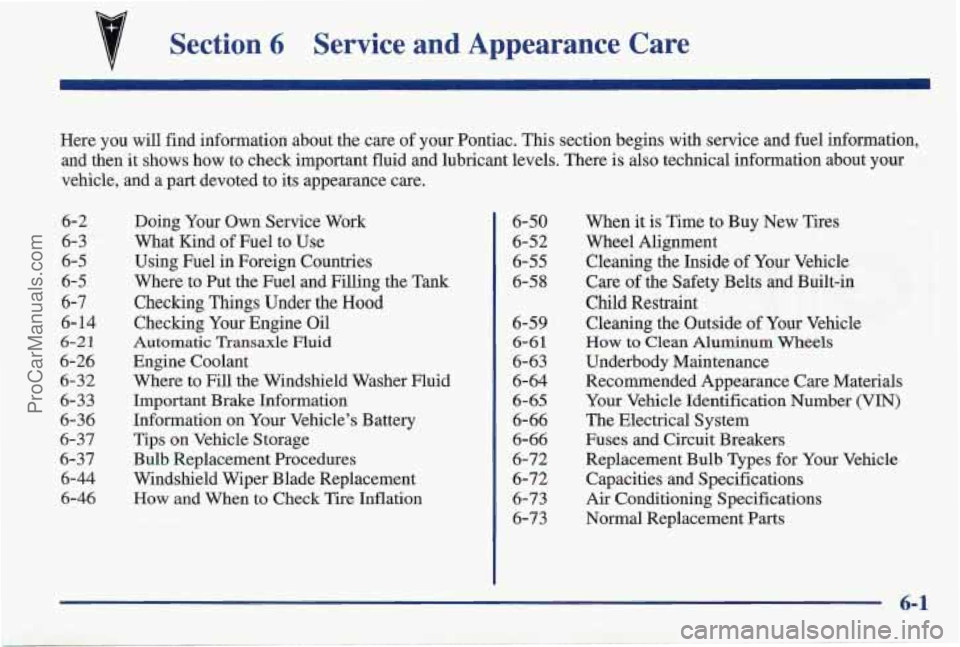
Section 6 Service and Appearance Care
Here you will find information about the care of your Pontiac. This section begins with service and fuel information,
and then it shows how to check important fluid and lubricant levels. There
is also technical information about your
vehicle, and a part devoted to its appearance care.
6-2
6-3 6-5
6-5
6-7
6- 14
6-2 1
6-26
6-32
6-33 6-36
6-37
6-37 6-44
6-46
Doing Your Own Service Work
What Kind of Fuel to Use
Using Fuel in Foreign Countries
Where to Put the Fuel and Filling the Tank
Checking
Things Under the Hood
Checking Your Engine Oil
Automatic Transaxle Fluid
Engine Coolant
Where to Fill the Windshield Washer Fluid
Important Brake Information
Information on Your Vehicle’s Battery
Tips on Vehicle Storage
Bulb Replacement Procedures
Windshield Wiper Blade Replacement
How and When to Check Tire Inflation 6-50
6-52
6-55
6-58
6-59
6-61
6-63
6-64
6-65 6-66
6-66
6-72
6-72
6-73
6-73 When
it is Time to Buy New Tires
Wheel Alignment
Cleaning the Inside of Your Vehicle
Care of the Safety Belts and Built-in
Child Restraint
Cleaning the Outside of Your Vehicle
How to Clean Aluminum Wheels
Underbody Maintenance
Recommended Appearance
Care Materials
Your Vehicle Identification Number (VIN)
The Electrical System
Fuses and Circuit Breakers
Replacement Bulb Types for Your Vehicle
Capacities and Specifications
Air Conditioning Specifications
Normal Replacement Parts
ProCarManuals.com
Page 272 of 419
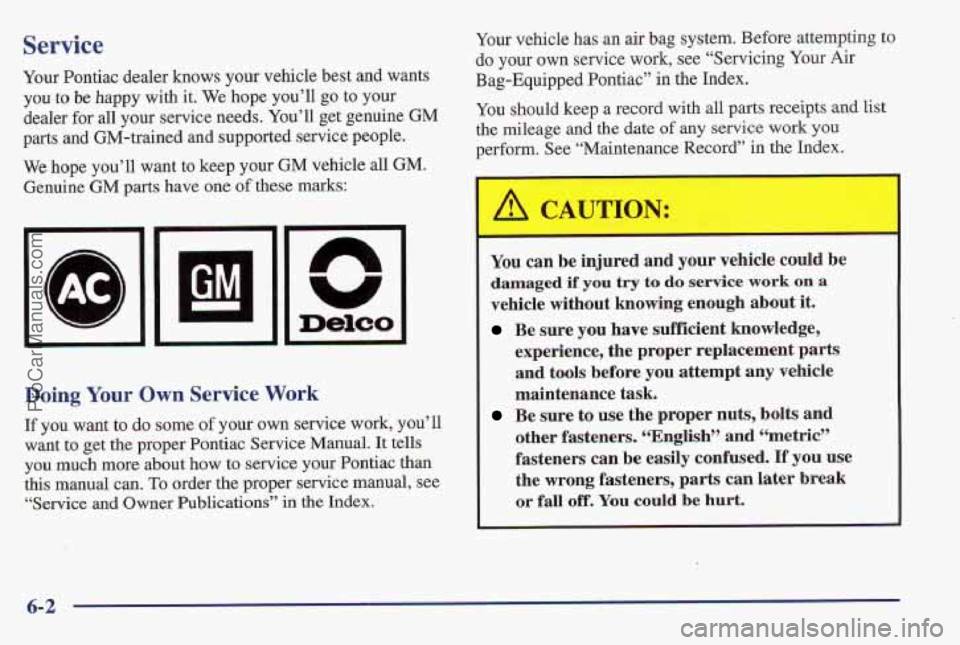
Service
Your Pontiac dealer knows your vehicle be,st and wants
you
tu be happy with it. We hope you’ll go to your
dealer
for all your service needs. You’ll get genuine GM
parts and GM-trained and supported service people.
We hope you’ll want to keep
your GM vehicle all GM.
Genuine GM parts have one of these marks:
Deleo
-.
Doing Your Own Service . hrk
~~
If you want to do some of your own service work, you’ll
want
to get the groper Pontiac Service Manual. It tells
you
much more about how to service your Pontiac than
this manual can.
To order the proper service manual, see
“Service and O’wner
Publications” in the Index. Your
vehicle
has an air bag system. Before attempting to
do your own sewice work, see “Servicing Your Air
Bag-Equipped Pontiac”
in the Index.
You should keep a record with all parts receipts and list
the mileage and the date of any service work you
perform, See “Maintenance Record” in the Index,
You can be injured and your vehicle could be
damaged if you try to do service work on a
vehicle without knowing enough about it.
Be sure you have sumcient knowledge,
experience, the proper replacement parts
and tools before you attempt any vehicle
maintenance
task.
Be sure to use the proper nuts, bolts and
other fasteners. C‘English” and (‘metric”
fasteners can be easily confused,
If you use
the wrong fasteners, parts can
later break
or fall off. You could be hurt.
6-2
ProCarManuals.com
Page 273 of 419
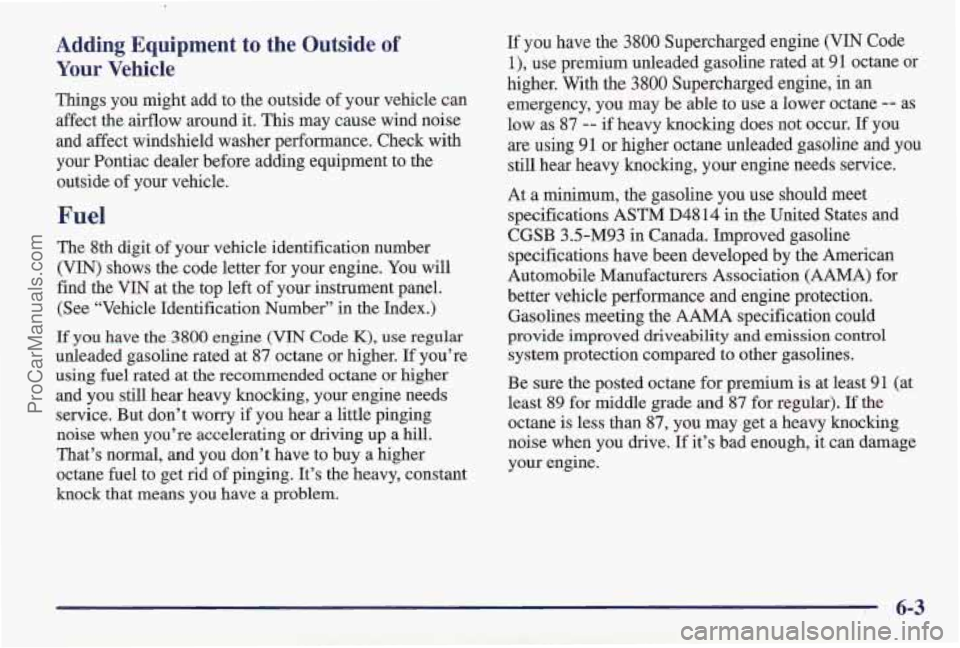
Adding Equipment to the Outside of
Your Vehicle
Things you might add to the outside of your vehicle can
affect the airflow around it. This may cause wind noise
and affect windshield washer performance. Check with
your Pontiac dealer before adding equipment to the
outside of your vehicle.
Fuel
The 8th digit of your vehicle identification number
(VIN) shows the code letter for your engine. You will
find the VIN at the top left
of your instrument panel.
(See “Vehicle Identification Number” in the Index.)
If you have the 3800 engine (VIN Code K), use regular
unleaded gasoline rated at 87 octane or higher. If you’re
using fuel rated at the recommended octane or higher
and you still hear heavy knocking, your engine needs
service. But don’t worry if you hear a little pinging
noise when you’re accelerating or driving up a hill.
That’s normal, and you don’t have to buy a higher
octane fuel to get rid of pinging. It’s the heavy, constant
knock that means you have
a problem.
If you have the 3800 Supercharged engine (VIN Code
l), use premium unleaded gasoline rated at 91 octane or
higher. With
the 3800 Supercharged engine, in an
emergency, you may be able
to use a lower octane -- as
low as 87
-- if heavy knocking does not occur. If you
are using 91 or higher octane unleaded gasoline and you
still hear heavy knocking, your engine needs service.
At
a minimum, the gasoline you use should meet
specifications ASTM D48
14 in the United States an’d
CGSB 3.5-M93 in Canada. Improved gasoline
specifications have been developed by the American
Automobile Manufacturers Association (AAMA) for
better vehicle performance and engine protection.
Gasolines meeting the AAMA specification could
provide improved driveability
and emission control
system protection compared to other gasolines.
Be sure the posted octane for premium is at least 91 (at
least 89 for middle grade and
87 for regular). If the
octane is less than 87, you may get a heavy knocking
noise when you drive.
If it’s bad enough, it can damage
your engine.
ProCarManuals.com
Page 274 of 419
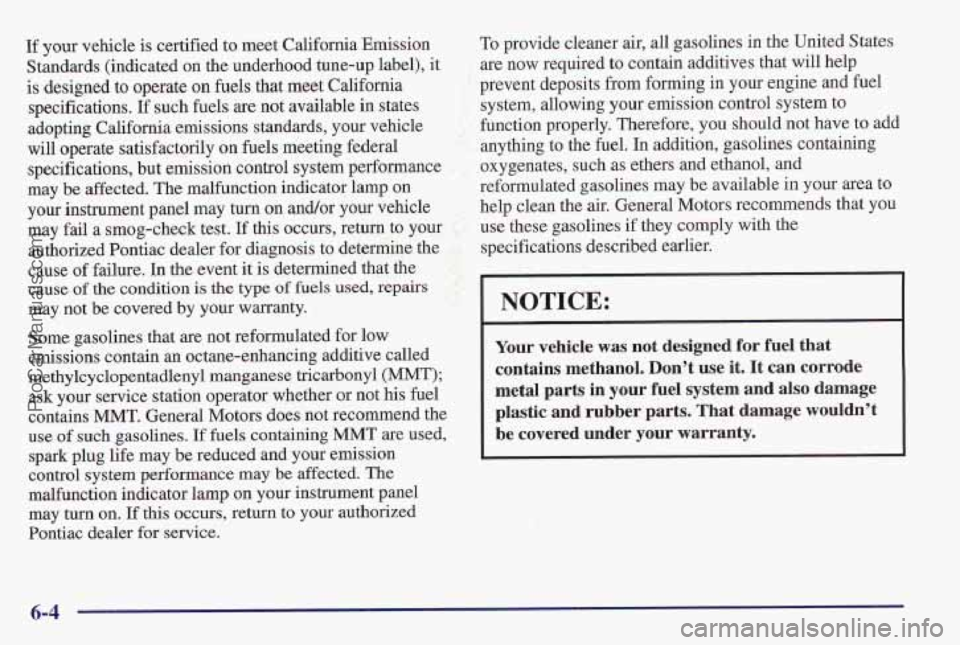
If your vehicle is certified to meet California Emission
Standards (indicated on the underhood tune-up label),
it
is designed to operate on fuels that meet California
specifications. If such fuels
are not available in states
adopting California emissions standards, your vehicle
will operate satisfactorily on fuels
meeting federal
specifications, but emission control system performance
may be affected. The malfunction indicator lamp
on
your instrument panel may turn on and/or your vehicle
may fail a smog-check test.
If this occurs, return to your
authorized Pontiac dealer for diagnosis to determine
the
cause of failure. In the event it is determined that the
cause of
the condition is the type of fuels used, repairs
may not be covered by your warranty.
Some gasolines that
are not reformulated for low
emissions contain an octane-enhancing additive called
methylcyclopentadlenyl manganese tricarbonyl (MMT); ask your service station operator whether or not his fuel
contains
MMT. General Motors does not recommend the
use of such gasolines. If fuels containing MMT are used,
spark plug life may be reduced and your ernissicrn
control
system performance may be affected. The
malfunction indicator lamp
on your instrument panel
may
turn on. If this occurs, return to your authorized
Pontiac dealer
€or service.
To provide cleaner ais, all gasolines in the United States
are now required to contain additives that will help
prevent deposits
from forming in your engine and fuel
system, allowing your emission control system to
function properly. Therefore,
you should not have to add
anything to the
fuel. In addition, gasolines containing
oxygenates, such as ethers and ethanol, and
reforrnulate'd gasolines may
be available in your area to
help clean the air. General Motors recommends that you
use these gasolines
if they comply with the
specifications described earlier.
~~
NOTICE:
Your vehicle was not designed for fuel that
contains methanol. Don't use it. It
can corrode
metal parts in
your fuel system and also damage
plastic and
rubber parts. That damage wouldn't
be covered under
your warranty.
_____~~
6-4
ProCarManuals.com
Page 275 of 419
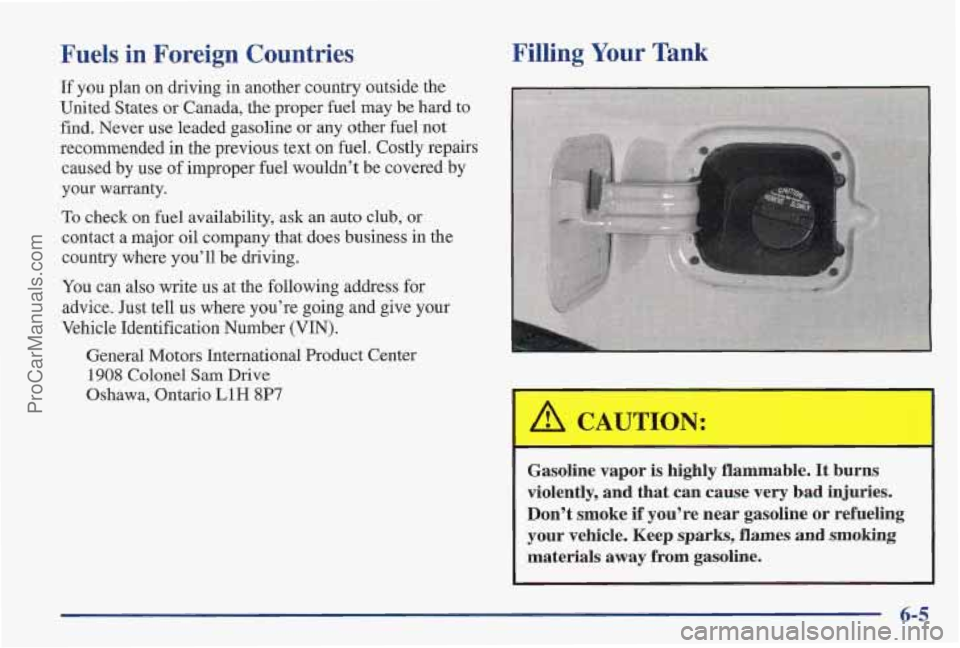
Fuels in Foreign Countries
If you plan on driving in another country outside the
United States
or Canada, the proper fuel may be hard to
find. Never use leaded gasoline or any other fuel not
recommended in the previous text on fuel. Costly repairs
caused by use
of improper fuel wouldn’t be covered by
your warranty.
To check on fuel availability, ask an auto club, or
contact a major oil company that does business in the
country where you’ll be driving.
You can also write us at the following address for
advice. Just tell
us where you’re going and give your
Vehicle Identification Number (VIN).
General Motors International Product Center
1908 Colonel Sam Drive
Oshawa, Ontario L1H 8P7
Filling Your Tank
I
Gasoline vapor is highly flammable. It burns
violently, and that can cause very
bad injuries.
Don’t
smoke if you’re near gasoline or refueling
your vehicle. Keep sparks,
flames and smoking
materials away from gasoline.
6-5
ProCarManuals.com
Page 276 of 419
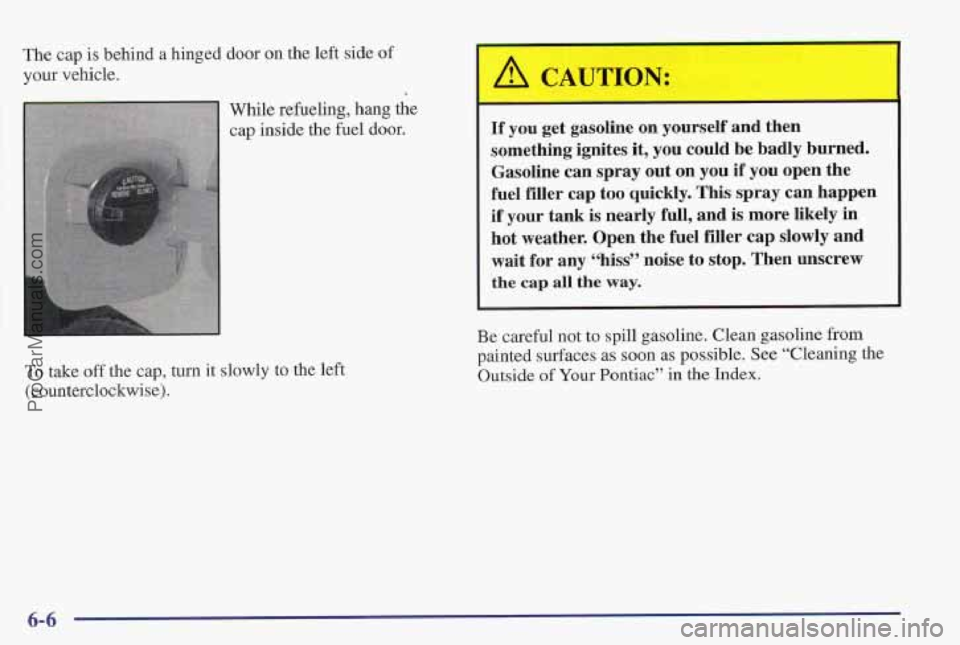
The cap is behind a hinged door on the left side of
vour vehicle.
While refueling, hang the
cap inside the fuel door.
To take off the cap, turn it slowly to the left
(counterclockwise).
If you get gasoline on yourself and then
something ignites
it, you could be badly burned.
Gasoline can spray out on you
if you open the
fuel filler cap too quickly. This spray can happen
if your tank is nearly full, and is more likely in
hot weather. Open the fuel filler cap
slowly and
wait for any
“hiss” noise to stop. Then unscrew
the cap all the way.
~ ~~
Be careful not to spill gasoline. Clean gasoline from
painted surfaces
as soon as possible. See “Cleaning the
Outside of Your Pontiac” in the Index.
6-6
ProCarManuals.com
Page 277 of 419
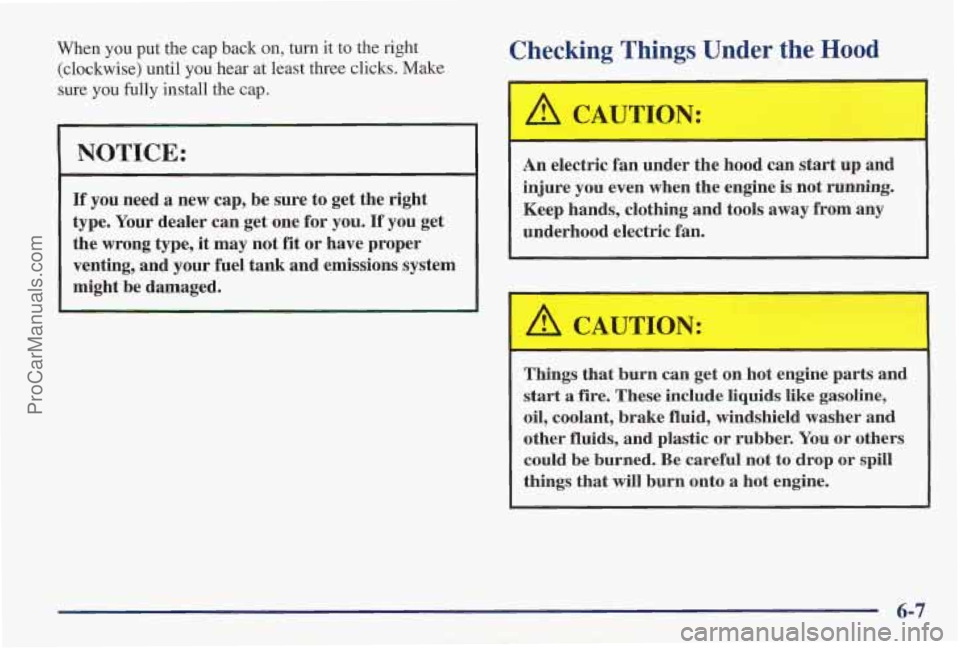
When you put the cap back on, turn it to the right
(clockwise) until you hear at least three clicks. Make
sure you fully install the cap.
NOTICE:
If you need a new cap, be sure to get the right
type. Your dealer can get one for you.
If you get
the wrong type, it may not
fit or have proper
venting, and your fuel tank and emissions system
might be damaged.
Checking Things Under the Hood
A CAUTION:
An electric fan under the hood can start up and
injure you even when the engine is not running.
Keep hands, clothing and tools
away from any
underhood electric fan.
Things that burn can get on hot engine parts and
start
a fire. These include liquids like gasoline,
oil, coolant, brake fluid, windshield washer and
other fluids, and plastic
or rubber. You or others
could
be burned. Be careful not to drop or spill
things that will burn onto
a hot engine.
6-7
ProCarManuals.com
Page 278 of 419
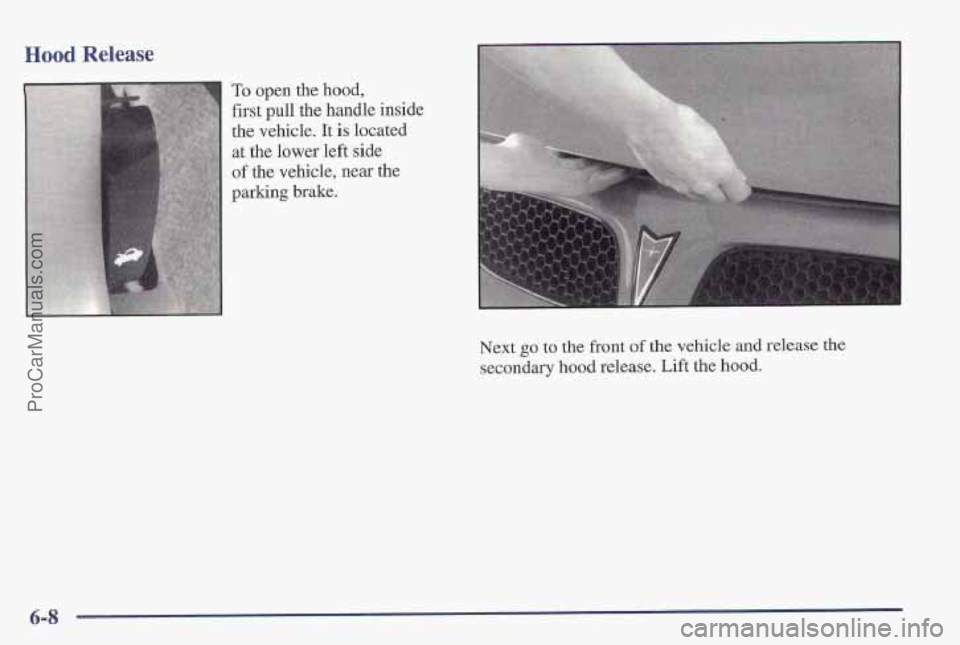
Hood Release
To open the hood,
first pull the handle inside
the vehicle. It
is located
at
the lower left side
of the vehicle, near the
parking brake.
Next go to the front of the vehicle and release the
secondary hood release. Lift the hood.
6-8
ProCarManuals.com
Page 279 of 419
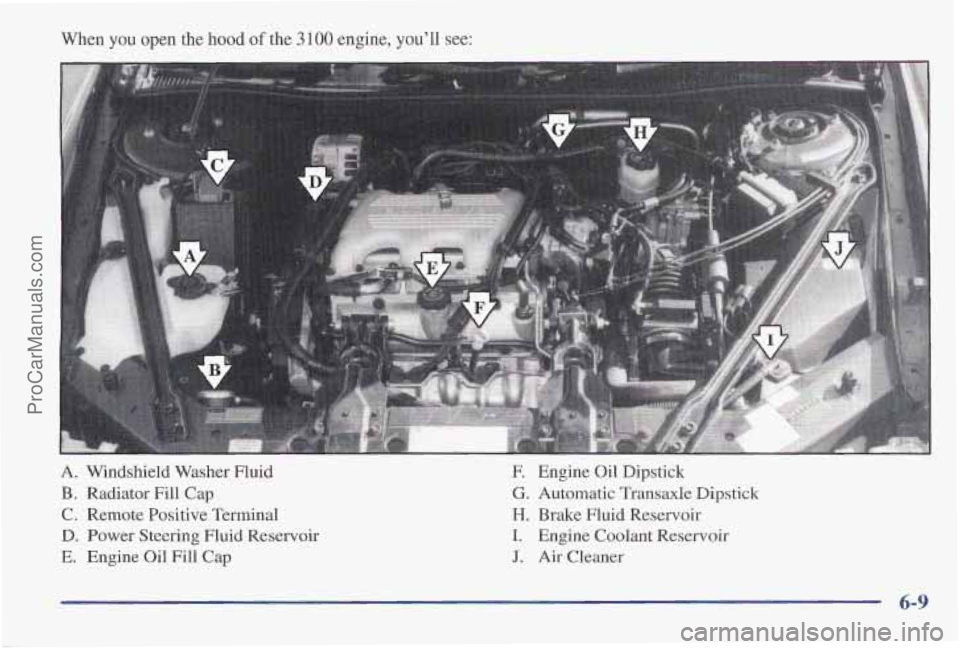
When you open the hood of the 3 100 engine, you’ll see:
A. Windshield Washer Fluid
B. Radiator Fill Cap
C. Remote Positive Terminal
D. Power Steering Fluid Reservoir
E. Engine Oil Fill Cap
E Engine Oil Dipstick
G. Automatic Transaxle Dipstick
H. Brake Fluid Reservoir
I. Engine Coolant Reservoir
J. Air Cleaner
6-9
ProCarManuals.com
Page 280 of 419
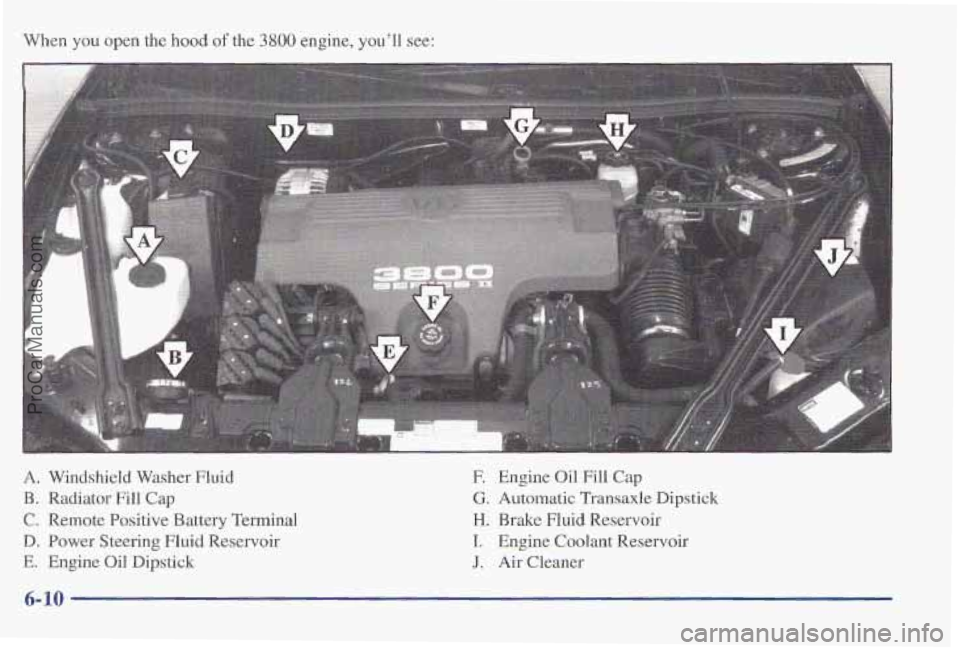
When you open the hood of the 3800 engine, you’ll see:
A. Windshield Washer Fluid E Engine Oil Fill Cap
€3. Radiator Fill Cap G. Automatic Transaxle Dipstick
C. Remote Positive Battery Terminal H. Brake Fluid Reservoir
D. Power Steering Fluid Reservoir I. Engine Coolant Reservoir
E. Engine Oil Dipstick J. Air Cleaner
6-10
ProCarManuals.com